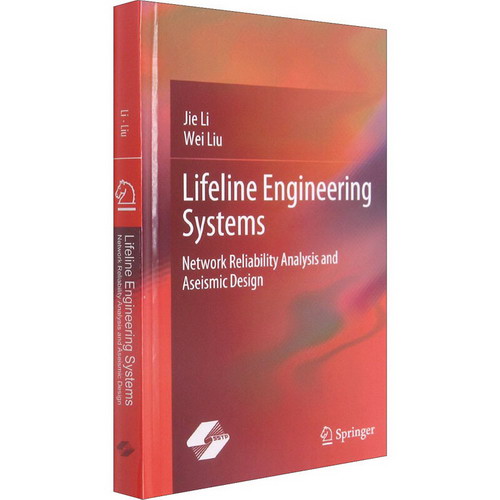| | | | 生命線工程繫統 網絡可靠性分析與抗震設計 圖書 | | 該商品所屬分類:圖書 -> 環境科學 | | 【市場價】 | 1590-2304元 | | 【優惠價】 | 994-1440元 | | 【作者】 | 李傑劉威 | | 【出版社】 | 上海科學技術出版社 | | 【ISBN】 | 9787547854167 | | 【折扣說明】 | 一次購物滿999元台幣免運費+贈品
一次購物滿2000元台幣95折+免運費+贈品
一次購物滿3000元台幣92折+免運費+贈品
一次購物滿4000元台幣88折+免運費+贈品
| | 【本期贈品】 | ①優質無紡布環保袋,做工棒!②品牌簽字筆 ③品牌手帕紙巾
|
|
| 版本 | 正版全新電子版PDF檔 | | 您已选择: | 正版全新 | 溫馨提示:如果有多種選項,請先選擇再點擊加入購物車。*. 電子圖書價格是0.69折,例如了得網價格是100元,電子書pdf的價格則是69元。
*. 購買電子書不支持貨到付款,購買時選擇atm或者超商、PayPal付款。付款後1-24小時內通過郵件傳輸給您。
*. 如果收到的電子書不滿意,可以聯絡我們退款。謝謝。 | | | |
| | 內容介紹 | |

出版社:上海科學技術出版社 ISBN:9787547854167 商品編碼:10041050697293 品牌:文軒 出版時間:2021-09-01 代碼:265 作者:李傑,劉威
"
 作 者:李傑,劉威 著  定 價:265  出 版 社:上海科學技術出版社  出版日期:2021年09月01日  頁 數:220  裝 幀:精裝  ISBN:9787547854167   ●1 Introduction
1.1 Lifeline Engineering Systems
1.2 Damages of Lifeline Systems in Past Earthquakes
1.3 Main Content of the Book
References
2 Seismic Hazard Assessment
2.1 Introduction
2.2 Uncertainty and Probability Model
2.2.1 Earthquake Occurrence Probability Model
2.2.2 Potential Seismic Zone
2.2.3 Probability Distribution Function of Earthquake Magnitude
2.2.4 Ground Motion Attenuation
2.3 Seismic Hazard Analysis Method
2.3.1 Point-Source Model
2.3.2 Line-Source Model
2.3.3 Area-Source Model
2.3.4 Probability Distribution Function of Ground Motion Amplitude
References
3 Seismic Ground Motion Model
3.1 Introduction
3.2 Statistically-Based Model
3.2.1 Stationary and Non-stationary Processes
3.2.2 One-Dimensional Stochastic Process Model
3.2.3 Random Field Model
3.3 Physically-Based Model
3.3.1 Fourier Spectral Form of One-Dimensional Ground Motion
3.3.2 Seismic Source Spectrum
3.3.3 Transfer Function of the Path
3.3.4 Local Site Effect
3.3.5 One-Dimensional Ground Motion Model
3.3.6 Physical Random Field Model of Ground Motions
References
4 Seismic Performance Evaluation of Buried Pipelines
4.1 Seismic Damage of Buried Pipelines
4.1.1 Pipeline Damage in Past Earthquakes
4.1.2 Damage Characteristics of Buried Pipelines
4.1.3 Factors Affecting Buried Pipeline Damages
4.1.4 Empirical Statistics of Damage Ratio
4.2 Seismic Response Analysis of Buried Pipelines
4.2.1 Pseudo-static Analysis Method
4.2.2 Pipeline Stress Computation
4.3 Seismic Response Analysis of Pipeline Networks
4.4 Seismic Reliability Evaluation of Buried Pipeline
4.4.1 Uncertainty of Pipeline Resistance
4.4.2 Seismic Reliability Analysis of Buried Pipelines
References
5 Seismic Response Analysis of Structures
5.1 Structural Analysis Model
5.1.1 General Finite Element Model
5.1.2 Seismic Analysis Model of Structure-Equipment Systems
5.1.3 Dynamic Analysis Model of Structure Subject to lti-point Ground Motions
5.2 Deterministic Seismic Response Analysis of Structures
5.2.1 Linear Acceleration Algorithm
5.2.2 Generalized u-Algorithm
5.3 Stochastic Seismic Response Analysis of Structures
5.3.1 Principle of Preservation of Probability
5.3.2 The Generalized Probability Density Evolution Equation
5.3.3 Numerical Method for Solving General Probability Density Evolution Equation
5.4 Seismic Reliability Analysis of Structures
References
6 Seismic Reliability Analysis of Engineering Network(I)--Connectivity Reliability
6.1 Introduction
6.2 Foundation of System Reliability Analysis
6.2.1 Basic Concepts of Graph Theory
6.2.2 Structural Function of Network Systems
6.2.3 Reliability of Simple Network System
6.3 Minimal Path Algorithm
6.3.1 Adjacent Matrix Algorithm
6.3.2 Depth First Search Algorithm
6.3.3 Breadth First Search Algorithm
6.4 Disjoint Minimal Path Algorithm
6.4.1 Reliability Evaluation of Network System and Its Complexity
6.4.2 Disjoint Minimal Path Algorithm
6.4.3 Reliability Analysis Based on DMP Algorithm
6.5 Recursive Decomposition Algorithm
6.5.1 Related Theorems
6.5.2 RDA for Edge-Weighted Network
6.5.3 RDA for Node-Weighted Network
6.6 Cut-Based Recursive Decomposition Algorithm
6.6.1 Minimal Cut Searching Algorithm
6.6.2 Cut-Based Recursive Decomposition Algorithm
6.7 Reliability Analysis of Network with Dependent Failure
6.8 Monte Carlo Simulation Method
References
7 Seismic Reliability Analysis of Engineering Network (II)--The Functional Reliability
7.1 Introduction
7.2 Functional Analysis of Water Supply Network
7.3 Functional Analysis of Water Supply Network with Leakage
7.3.1 Hydraulic equation of water supply network with leakage
7.3.2 Analysis method
7.4 Seismic Functional Reliability Analysis of Water Supply Network
References
8 Aseismic Optimal Design ofLifeline Networks
8.1 Introduction
8.2 Network Topology Optimization Based on Connectivity Reliability
8.2.1 Topology Optimization Model
8.2.2 Genetic Algorithm
8.2.3 Examples
8.3 Topology Optimization of Water Supply Network
8.3.1 Optimization Model
8.3.2 Algorithms for Seismic Topology Optimization
8.3.3 EXamples
References
9 Simulation and Control of Composite Lifeline System
9.1 Introduction
9.2 Disaster Response Simulation ofComposite Lifeline System
9.2.1 Fundamentals of Discrete Event Dynamic Simulation
9.2.2 Simulation of Composite Lifeline Engineering System
9.2.3 Disaster Simulation Model of Composite Lifeline System
9.2.4 Simulation Convergence Criteria and Simulation Statistics
9.3 Petri Net Model for Disaster Simulation of Composite Lifeline System
9.3.1 Classic Petri Net
9.3.2 Non-Autonomous Colored Petri Net
9.3.3 Seismic Disaster Simulation of Composite Lifeline System
9.4 Case Study on Seismic Disaster Simulation
9.5 Urban Earthquake Disaster Field Control
9.5.1 System ControlBased on Structural Behavior
9.5.2 System Control Based on Investment Behavior
9.5.3 Case Study
References
Appendix A: Boolean Algebra Basic
Appendix B: Seismic Reliability Analysis of Transformer Substation
Appendix C: Seismic Secondary Fire Analysis
Bibliography
 本書全面介紹了生命線繫統網絡分析和抗震設計的相關內容和近期新研究進展,突破了傳統研究思路中重結構輕網絡、重連通輕功能、重分析輕設計的問題,構建了從結構分析到網絡功能分析再到網絡設計的研究思路,在國際上首次實現了生命線工程網絡連通可靠度的高效準確的遞推分解算法、地震下帶滲漏工作供水網絡功能可靠度的精細化分析方法、生命線工程網絡抗震優化設計以及復合生命線網絡建模和仿真。研究成果對於生命線工程領域的研究和工程應用具有重要意義。利用上述理論研究成果,進行了上海、瀋陽、鄭州等多個大型城市供水、供氣和電力繫統的抗震分析和設計工作。同時,汶川地震後,成果應用於四川省都江堰、綿竹等多個受災城市的震後恢復重建之中,得到了相關單位的高度評價。 
" | | |
| | | | |
|




